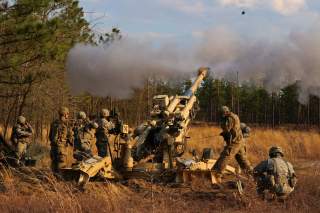America’s Next Army
Reinvesting in ready, modern, and forward-stationed ground forces
We also looked for opportunities to leverage new technologies to increase efficiencies and save costs. Robotics and automation provide tremendous opportunities in a variety of areas, and logistics in particular is ripe for disruptive innovation. We upgraded 25,000 tactical wheeled vehicles with low-cost autonomous applique kits to facilitate manned-unmanned convoy operations. This allowed us to cut 7,500 personnel, split evenly between the active and reserve component. Similarly, we acquired 200 new uninhabited autonomous cargo helicopters. This allowed us to reduce the UH-60 helicopter buy and cut 2,400 active duty personnel, all while increasing the total number of cargo helicopters in the force. Most of these personnel were redirected to higher-priority jobs, but some cuts resulted in outright savings that could be reinvested in additional capability. In the second FYDP active-duty end-strength dipped just below 450,000 to 449,000, but the force was more effective overall.
How did we fund all of this? We were willing to make tough choices and take on politically contentious issues. We seriously evaluated the balance between Army active and reserve components (AC/RC balance) and shifted forces where necessary. The result was an 11 percent reduction in Army reserve component end-strength. To date, the reserve component has largely been exempted from cuts in the current budget downturn, a decision driven more by politics than objective analysis. We chose to preserve combat power in the active duty in order to have the most ready forces available. We also adopted politically sensitive yet nevertheless reasonable reforms such as raising TRICARE fees, eliminating commissary subsidies, and initiating base realignment and closure (BRAC). These reforms netted $27 billion in savings that was reinvested back into the joint force. We also aggressively pursued management reforms to reduce civilian and contractor overhead in DoD through headquarters consolidation, de-layering, and automation to replace jobs. Across all of DoD, we took a five percent reduction in the civilian workforce and cut 8,000 contractors, resulting in a whopping $55 billion in savings.
In spite of all of these savings, we still couldn’t do everything we wanted. Many of the modernization initiatives we funded were only a down payment on the force of the future. We couldn’t always get the quantities of purchases we wanted. But we did begin the process of restoring readiness today and reorienting the force towards future threats. There were also other initiatives we would like to see the Army do that weren’t options in the strategic choices tool we used. The Army should explore new helmet designs to provide much-needed protection against blast-induced brain injury and conduct additional research into the causes of traumatic brain injury. Experimental exoskeletons and soft exosuits have shown potential to reduce soldier fatigue and increase mobility, and these technologies could be brought to fruition with an aggressive research and development program. Air and ground robots could be used in a variety of non-logistics functions, from aerial swarms for reconnaissance or active protection to robotic mules to accompany squads on patrol. The Army should exploit the potential of these emerging technologies to fundamentally improve dismounted soldier protection, mobility, and lethality.
In total, we invested $50 billion in the Army over ten years to build ready, modern, forward-stationed ground forces. We did it all within a constrained budget and without robbing other Services. The Army fights as part of a joint force and we similarly invested in air and sea power. We paid these bills by shifting resources from legacy forces that were less useful in the future security environment, such as cutting active duty infantry BCTs and reserve component end-strength. We also took on politically sensitive reforms across DoD as a whole. While these initiatives will require buy-in from the Office of the Secretary of Defense (OSD) and Congressional leadership, Army leaders can help by making clear their priorities. The presence of a new administration in January and a major defense strategy review next year are opportunities to take a fundamental look at the state of the Army. With support from OSD and Congress, the Army can make the necessary investments to restore readiness and prepare for future challenges.
Paul Scharre is a Senior Fellow and Director of the Future of Warfare Initiative at the Center for a New American Security. He is a former infantryman in the Army’s 75th Ranger Regiment with multiple tours to Iraq and Afghanistan.
Image: U.S. Army

